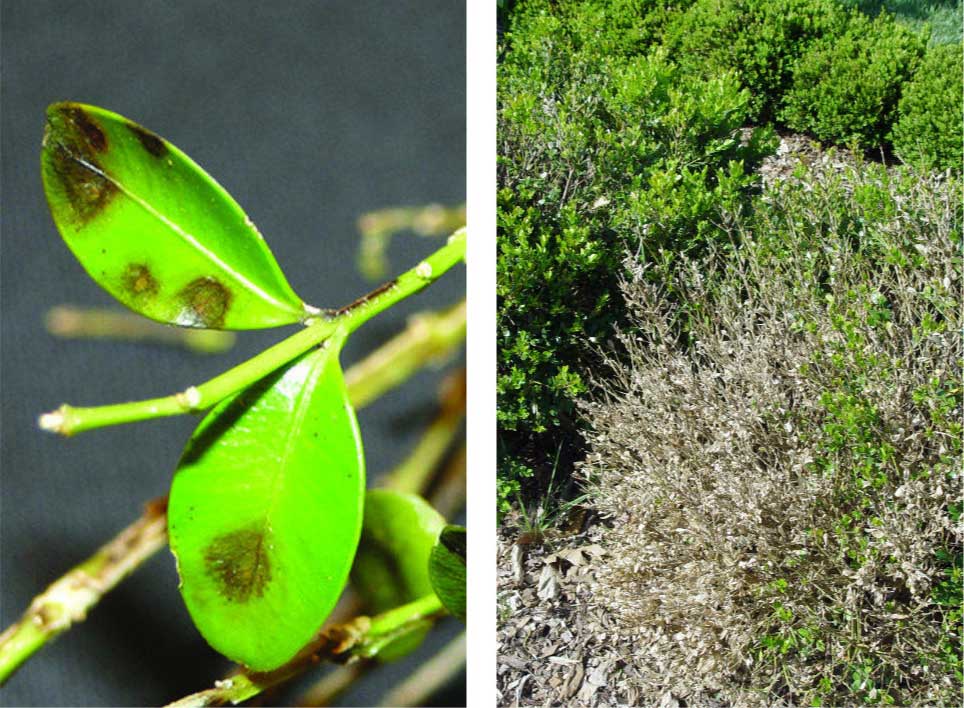What Happens to the Garden When You Get Too Much Rain?
Gardens need rain, but too much rainfall can cross the line. Learn what to do when excessive downpours or extended periods of wetness harm garden and landscape plants.

Boxwoods are at increased risk of disease because they’re often planted in masses or hedges and sheared to encourage dense growth that slows leaves from drying. Fotolichen / E + / Getty Images Plus
When boxwoods suddenly started dying in Connecticut and North Carolina yards in 2011, plant pathologists realized that a deadly new disease had made its way across the Atlantic Ocean.
British gardeners have been battling boxwood blight since the 1990s. In less than a decade, this killer of one of our leading landscape shrubs has spread to 26 U.S. states from the mid-Atlantic to the West Coast, despite efforts to stop it.
The infection caused by boxwood blight starts with round brown spots on shrub leaves and black streaks on the stems. Soon after, leaves brown and drop, ultimately leading to bare, dead plants.
The disease favors warm and damp conditions, which explains why blight flourished in the unusually wet summer and early fall that many regions had in 2018. Sadly it didn't stop there, with fungal spores that can survive cold winters and live in soil for up to five years at a time, the disease is still around today.
The good news is that the spores are heavy and sticky, making it difficult for them to travel by wind.
So how does a plant get boxwood blight? The main way is when new, infected boxwoods are brought into the landscape. Blight can also spread when spores are introduced by animals carrying them (deer, rodents, birds) or by people carrying them on their clothes and shoes. It can even spread on pruning equipment, blown-in leaf litter, and infected boxwood cuttings and wreaths bought for Christmas decorating.
Pachysandra and sweetbox (Sarcococca) are in the same plant family as boxwood and can also carry blight spores into a landscape.

An initial symptom of boxwood blight is small round brown spots on the leaves, left, soon followed by dropping of the leaves, right. Photos by University of Connecticut, University of Virginia
One way to fight blight is to avoid bringing new boxwoods, boxwood cuttings, pachysandra, or sweetbox into the yard. Or, before buying, check with your nursery or garden center to make sure their stock comes from a grower participating in one of the many state Boxwood Clean programs that require extra vigilance and inspection.
If you have boxwoods and live in a state where blight has been confirmed, be on the lookout for early spotting and sudden browning of leaves. Infected boxwoods and their fallen leaves can be removed to lessen the odds of blight spreading elsewhere.
There is no known cure to heal affected plants, but uninfected boxwoods can be protected with fungicide sprays. University Extension offices say treatments are needed every 7-14 days during the growing season and that chlorothalonil (Daconil) is the most effective fungicide available to home-owners for these treatments.
And, if you suspect boxwood blight, report it to your county Extension office or your state Department of Agriculture.
Fortunately, not all types of boxwoods are susceptible to blight. While English boxwoods (Buxus sempervirens ‘Suffruticosa’) are most prone, American boxwoods are somewhat resistant, and the species microphylla, insularis, and harlandii are most resistant to the disease.
Trials by Saunders Brothers Nursery and North Carolina State University also found the following varieties to be among the most blight-resistant: ‘Dee Runk,’ ‘Fastigiata,’ ‘Franklin’s Gem,’ ‘Golden Dream,’ ‘Green Beauty,’ Buxus insularis ‘Nana,’ ‘Jim Stauffer,’ ‘John Baldwin,’ ‘Little Missy,’ ‘Richard,’ ‘Winter Gem,’ and ‘Wintergreen.’ Saunders Brothers is introducing a new line of boxwoods called NewGen in 2020 that are specifically selected to resist both blight and leafminers.
Whatever boxwood you choose to plant, remember that it will grow best in well-drained soil that’s slightly acidic, and in sites with morning sun and some afternoon shade.